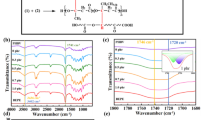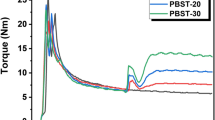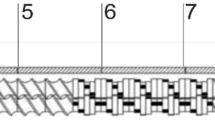Abstract
A one-step reactive extrusion process has been demonstrated to toughen the poly(lactic acid) (PLA) blend without sacrificing its mechanical strength and degradability. Specifically, poly(lactic acid) (PLA), poly(3-hydroxybutyrate-co-3-hydroxyvalerate) (PHBV), and the peroxide initiator were first introduced into the mixer and then heated at the elevated temperatures for triggering the grafting reaction during the extrusion. During this process, the thermal decomposition of PHBV results in the unsaturated bonds that can directly grafted onto the PLA backbones by free radical reactions. From this study, we found that PLA/PHBV blend with a mass ratio of 80/20 (PLA/PHBV) and 0.3 wt% 2,5-dimethyl-2,5-di(tert-butylperoxy)hexane (DBPH) is an optimized condition, leading to an improved elongation at break of 15.95%, which is 3.1 times of the PLA and 1.5 times of the PLA/PHBV blend without the initiator, while tensile strength exhibited very limited decreased compared to PLA. Overall, this work presents an environmentally friendly and industrial feasible approach to prepare bio-based toughened PLA for improving the elongation at break, while retaining the tensile strength and degradability.











Similar content being viewed by others
References
Guzdemir OO, Bermudez V, Kanhere S, Ogale AA (2020) Melt-spun poly(lactic acid) fibers modified with soy fillers: toward environment-friendly disposable nonwovens. Polym Eng Sci 60:1158–1168. https://doi.org/10.1002/pen.25369
Pan G, Xu H, Ma B, Wizi J, Yang Y (2018) Polylactide fibers with enhanced hydrolytic and thermal stability via complete stereo-complexation of poly(l-lactide) with high molecular weight of 600000 and lower-molecular-weight poly(d-lactide). J Mater Sci 53:5490–5500. https://doi.org/10.1007/s10853-017-1944-2
Jayanth D, Kumar PS, Nayak GC, Kumar JS, Pal SK, Rajasekar R (2018) A review on biodegradable polymeric materials striving towards the attainment of green environment. J Polym Environ 26:838–865. https://doi.org/10.1007/s10924-017-0985-6
Muthuraj R, Misra M, Mohanty AK (2018) Biodegradable compatibilized polymer blends for packaging applications: a literature review. J Appl Polym Sci 135:45726. https://doi.org/10.1002/app.45726
Thulasisingh A, Kumar K, Yamunadevi B, Poojitha N, SuhailMadharHanif S, Kannaiyan S (2021) Biodegradable packaging materials. Polym Bull. https://doi.org/10.1007/s00289-021-03767-x
Scaffaro R, Maio A, Sutera F, Gulino EF, Morreale M (2019) Degradation and recycling of films based on biodegradable polymers: a short review. Polymers 11:651. https://doi.org/10.3390/polym11040651
Larranaga A, Lizundia E (2019) A review on the thermomechanical properties and biodegradation behaviour of polyesters. Eur Polymer J 121:109296. https://doi.org/10.1016/j.eurpolymj.2019.109296
Nofar M, Sacligil D, Carreau PJ, Kamal MR, Heuzey MC (2018) Poly (lactic acid) blends: processing, properties and applications. Int J Biol Macromol 125:307–360. https://doi.org/10.1016/j.ijbiomac.2018.12.002
Purnama P, Lim SH, Kim JSH (2012) Stereocomplex-nanocomposite formation of polylactide/fluorinated-clay with superior thermal property using supercritical fluid. Macromol Res 20:545–548. https://doi.org/10.1007/s13233-012-0092-4
Farah S, Anderson DG, Langer R (2016) Physical and mechanical properties of PLA, and their functions in widespread applications—a comprehensive review. Adv Drug Deliv Rev 107:367–392. https://doi.org/10.1016/j.addr.2016.06.012
Masutani K, Kobayashi K, Kimura Y, Lee CW (2018) Properties of stereo multi-block polylactides obtained by chain-extension of stereo tri-block polylactides consisting of poly(L-lactide) and poly(D-lactide). J Polym Res 25:74. https://doi.org/10.1007/s10965-018-1444-3
Murariu M, Dubois P (2016) PLA composites: from production to properties. Adv Drug Deliv Rev 107:17–46. https://doi.org/10.1016/j.addr.2016.04.003
Chalermpanaphan V, Choochottiros C (2021) Synthesis of unsaturated aliphatic polyester-based copolymer: effect on the ductility of PLA blend and crosslink. Polym Bull. https://doi.org/10.1007/s00289-021-03596-y
Zhou Y, Wang J, Cai SY, Wang ZG, Zhang NW, Ren J (2018) Effect of POE-g-GMA on mechanical, rheological and thermal properties of poly(lactic acid)/poly(propylene carbonate) blends. Polym Bull 75:5437–5454. https://doi.org/10.1007/s00289-018-2339-5
Tebaldi ML, Chaves Maia AL, Poletto F, de Andrade FV, Ferreira Soares DC (2019) Poly(-3-hydroxybutyrate-co-3-hydroxyvalerate) (PHBV): current advances in synthesis methodologies, antitumor applications and biocompatibility. J Drug Delivery Sci Technol 51:115–126. https://doi.org/10.1016/j.jddst.2019.02.007
Goonoo N, Bhaw-Luximon A, Passanha P, Esteves SR, Jhurry D (2017) Third generation poly(hydroxyacid) composite scaffolds for tissue engineering. J Biomed Mater Res Part B-Appl Biomater 105:1667–1684. https://doi.org/10.1002/jbm.b.33674
Rivera-Briso AL, Serrano-Aroca A (2018) Poly(3-hydroxybutyrate-co-3-hydroxyvalerate): enhancement strategies for advanced applications. Polymers 10:732. https://doi.org/10.3390/polym10070732
Ling C, Qiao GQ, Shuai BW, Song KN, Yao WX, Jiang XR, Chen GQ (2019) Engineering self-flocculating Halomonas campaniensis for wastewaterless open and continuous fermentation. Biotechnol Bioeng 116:805–815. https://doi.org/10.1002/bit.26897
Mooninta S, Poompradub S, Prasassarakich P (2020) Packaging film of PP/LDPE/PLA/Clay composite: physical, barrier and degradable properties. J Polym Environ 28:3116–3128. https://doi.org/10.1007/s10924-020-01840-6
You X, Snowdon MR, Misra M, Mohanty AK (2018) Biobased poly(ethylene terephthalate)/poly(lactic acid) blends tailored with epoxide compatibilizers. ACS Omega 3:11759–11769. https://doi.org/10.1021/acsomega.8b01353
Srisuwan S, Ruksakulpiwat Y, Chumsamrong P (2020) Effect of triblock copolymers based on liquid natural rubber and low molecular weight poly(lactic acid) on physical properties of poly(lactic acid)/natural rubber blend. Polym Bull 78:1253–1273. https://doi.org/10.1007/s00289-020-03158-8
Lei W, Yang X, Qiao H, Dean S, Wang R, Zhang L (2018) Renewable resource-based elastomer nanocomposite derived from myrcene, ethanol, itaconic acid and nanosilica: design, preparation and properties. Eur Polymer J 106:1–8. https://doi.org/10.1016/j.eurpolymj.2018.04.006
Dhaliwal GS, Anandan S, Chandrashekhara K, Lees J, Nam P (2018) Development and characterization of polyurethane foams with substitution of polyether polyol with soy-based polyol. Eur Polymer J 107:105–117. https://doi.org/10.1016/j.eurpolymj.2018.08.001
Sahu P, Bhowmick AK, Kali G (2020) Terpene based elastomers: synthesis, properties, and applications. Processes 8:553. https://doi.org/10.3390/pr8050553
Alias NF, Ismail H (2019) An overview of toughening polylactic acid by an elastomer. Polym-Plast Technol Mater 58:1399–1422. https://doi.org/10.1080/25740881.2018.1563118
Zhang H, Deng B, Liu Q, Cong W (2015) Blends of polylactide and poly(3-hydroxybutyrate-co-3-hydroxyvalerate) with low content of hydroxyvalerate unit: morphology, structure, and property. J Appl Polym Sci 132:42689. https://doi.org/10.1002/app.42689
Jost V, Miesbauer O (2017) Effect of different biopolymers and polymers on the mechanical and permeation properties of extruded PHBV cast films. J Appl Polym Sci 135:46153. https://doi.org/10.1002/app.46153
Zhang K, Mohanty AK, Misra M (2012) Fully biodegradable and biorenewable ternary blends from polylactide, poly(3-hydroxybutyrate-co-hydroxyvalerate) and Poly(butylene succinate) with balanced properties. ACS Appl Mater Interfaces 4:3091–3101. https://doi.org/10.1021/am3004522
Li LZ, Huang W, Wang BJ, Wei WF, Gu Q, Chen P (2015) Properties and structure of polylactide/poly (3-hydroxybutyrate-co-3-hydroxyvalerate) (PLA/PHBV) blend fibers. Polymer 68:183–194. https://doi.org/10.1016/j.polymer.2015.05.024
Formela K, Zedler L, Hejna A, Tercjak A (2018) Reactive extrusion of bio-based polymer blends and composites–current trends and future developments. Express Polym Lett 12:24–57. https://doi.org/10.3144/expresspolymlett.2018.4
Yves Y, Benjamin G, Nicolas LM, Marion J, Frédéric L, Jean M, Thomas XM (2018) Peptide couplings by reactive extrusion: solid-tolerant and free from carcinogenic, mutagenic and reprotoxic chemicals. Acs Sustain Chem Eng 6:16001–16004. https://doi.org/10.1021/acssuschemeng.8b04509
Zhao D, Yan D, Zhang N, Yang G (2019) Preparation of super-toughened PA6 with submicron-sized ABS by in situ reactive extrusion method. Mater Lett 251:18–22. https://doi.org/10.1016/j.matlet.2019.05.029
Rigoussen A, Verge P, Raquez JM, Habibi Y, Dubois P (2017) In-depth investigation on the effect and role of cardanol in the compatibilization of PLA/ABS immiscible blends by reactive extrusion. Eur Polymer J 93:272–283. https://doi.org/10.1016/j.eurpolymj.2017.06.004
Wang Y, Mei Y, Wang Q, Wei W, Huang F, Li Y, Li J, Zhou Z (2019) Improved fracture toughness and ductility of PLA composites by incorporating a small amount of surface-modified helical carbon nanotubes. Compos Part B-Eng 162:54–61. https://doi.org/10.1016/j.compositesb.2018.10.060
Wang M, Wu Y, Li YD, Zeng JB (2017) Progress in toughening poly(lactic acid) with renewable polymers. Polym Rev 57:557–593. https://doi.org/10.1080/15583724.2017.1287726
Zhang NW, Zeng C, Wang L, Ren J (2012) Preparation and properties of biodegradable poly(lactic acid)/poly(butylene adipate-co-terephthalate) blend with epoxy-functional styrene acrylic copolymer as reactive agent. J Polym Environ 21:286–292. https://doi.org/10.1007/s10924-012-0448-z
Mo XZ, Wei FX, Tan DF, Pang JY, Lan CB (2020) The compatibilization of PLA-g-TPU graft copolymer on polylactide/thermoplastic polyurethane blends. J Polym Res 27:33. https://doi.org/10.1007/s10965-019-1999-7
Wang FY, Dai L, Ge TT, Yue CB, Song YM (2020) alpha-methylstyrene-assisted maleic anhydride grafted poly(lactic acid) as an effective compatibilizer affecting properties of microcrystalline cellulose/poly(lactic acid) composites. Express Polym Lett 14:530–541. https://doi.org/10.3144/expresspolymlett.2020.43
Marsilla KIK, Verbeek CJR (2017) Crystallization of itaconic anhydride grafted poly(lactic acid) during annealing. J Appl Polym Sci 134:44614. https://doi.org/10.1002/app.44614
Abdelwahab MA, Jacob S, Misra M, Mohanty AK (2021) Super-tough sustainable biobased composites from polylactide bioplastic and lignin for bio-elastomer application. Polymer 212:123153. https://doi.org/10.1016/j.polymer.2020.123153
Bäckström E, Odelius K, Hakkarainen M (2019) Designed from recycled: turning polyethylene waste to covalently attached polylactide plasticizers. ACS Sustain Chem Eng 7:11004–11013. https://doi.org/10.1021/acssuschemeng.9b02092
Xiang H, Wen X, Miu X, Li Y, Zhou Z, Zhu M (2016) Thermal depolymerization mechanisms of poly(3-hydroxybutyrate-co-3-hydroxyvalerate). Prog Nat Sci Mater Int 26:58–64. https://doi.org/10.1016/j.pnsc.2016.01.007
Nguyen S, Yu GE, Marchessault RH (2002) Thermal degradation of poly(3-hydroxyalkanoates): preparation of well-defined oligomers. Biomacromol 3:219–224. https://doi.org/10.1021/bm0156274
Hablot E, Bordes P, Pollet E, Avérous L (2008) Thermal and thermo-mechanical degradation of poly(3-hydroxybutyrate)-based multiphase systems. Polym Degrad Stab 93:413–421. https://doi.org/10.1016/j.polymdegradstab.2007.11.018
Du J, Wang Y, Xie X, Xu M, Song Y (2017) Styrene-assisted maleic anhydride grafted poly(lactic acid) as an effective compatibilizer for wood flour/poly(lactic acid) bio-composites. Polymers 9:623. https://doi.org/10.3390/polym9110623
Zhou KY, Li JB, Wang HX, Ren J (2017) Effect of Star-shaped chain architectures on the polylactide stereocomplex crystallization behaviors. Chin J Polym Sci 35:974–991. https://doi.org/10.1007/s10118-017-1935-4
Zembouai I, Kaci M, Bruzaud S, Benhamida A, Grohens Y (2013) A study of morphological, thermal, rheological and barrier properties of Poly(3-hydroxybutyrate-co-3-hydroxyvalerate)/polylactide blends prepared by melt mixing. Polym Testing 32:842–851. https://doi.org/10.1016/j.polymertesting.2013.04.004
Martins AB, Santana R (2019) Structure-properties correlation in PP/thermoplastic starch blends containing sustainable compatibilizer agent. Mater Res Express 6:095336. https://doi.org/10.1088/2053-1591/ab0f73
Teng CC, Ma CCM, Huang YW, Yuen SM, Weng CC, Chen CH, Su SF (2008) Effect of MWCNT content on rheological and dynamic mechanical properties of multiwalled carbon nanotube/polypropylene composites. Compos A Appl Sci Manuf 39:1869–1875. https://doi.org/10.1016/j.compositesa.2008.09.004
Du J, Guomin Z, Mingzhu P, Leilei Z, Dagang L, Rui Z (2017) Crystallization and mechanical properties of reinforced PHBV composites using melt compounding: effect of CNCs and CNFs. Carbohyd Polym 168:255–262. https://doi.org/10.1016/j.carbpol.2017.03.076
Zhao X, Cornish K, Vodovotz Y (2019) synergistic mechanisms underlie the peroxide and coagent improvement of natural-rubber-toughened poly(3-hydroxybutyrate-co-3-hydroxyvalerate) mechanical performance. Polymers 11:565. https://doi.org/10.3390/polym11030565
Liu G, Zhang X, Wang D (2015) Tailoring crystallization: towards high-performance poly(lactic acid). Adv Mater 26:6905–6911. https://doi.org/10.1002/adma.201305413
Greco A, Ferrari F, Maffezzoli A (2018) Thermal analysis of poly(lactic acid) plasticized by cardanol derivatives. J Therm Anal Calorim 134:559–565. https://doi.org/10.1007/s10973-018-7059-4
Leones A, Sonseca A, Lopez D, Fiori S, Peponi L (2019) Shape memory effect on electrospun PLA-based fibers tailoring their thermal response. Eur Polymer J 117:217–226. https://doi.org/10.1016/j.eurpolymj.2019.05.014
Jost V, Kopitzky R (2015) Blending of Polyhydroxybutyrate-co-valerate with polylactic acid for packaging applications—reflections on miscibility and effects on the mechanical and barrier properties. Chem Biochem Eng Q 29:221–246
Yang X, Clénet J, Xu H, Odelius K, Hakkarainen M (2015) Two step extrusion process: from thermal recycling of phb to plasticized PLA by reactive extrusion grafting of PHB degradation products onto PLA chains. Macromolecules 48:2509–2518. https://doi.org/10.1021/acs.macromol.5b00235
Zhao H, Cui Z, Sun X, Turng LS, Peng X (2013) Morphology and properties of injection molded solid and microcellular polylactic acid/polyhydroxybutyrate-valerate (PLA/PHBV) blends. Ind Eng Chem Res 52:2569–2581. https://doi.org/10.1021/ie301573y
Salahuddin N, Gaber M, Elneanaey S, Snowdon MR, Abdelwahab MA (2021) Co-delivery of norfloxacin and tenoxicam in Ag–TiO2/poly(lactic acid) nanohybrid. Int J Biol Macromol 180:771–781. https://doi.org/10.1016/j.ijbiomac.2021.03.033
Ma P, Spoelstra AB, Schmit P, Lemstra PJ (2013) Toughening of poly (lactic acid) by poly (β-hydroxybutyrate-co-β-hydroxyvalerate) with high β-hydroxyvalerate content. Eur Polymer J 49:1523–1531. https://doi.org/10.1016/j.eurpolymj.2013.01.016
Ma P, Cai X, Zhang Y, Wang S, Dong W, Chen M, Lemstra PJ (2014) In-situ compatibilization of poly(lactic acid) and poly(butylene adipate-co-terephthalate) blends by using dicumyl peroxide as a free-radical initiator. Polym Degrad Stab 102:145–151. https://doi.org/10.1016/j.polymdegradstab.2014.01.025
Acknowledgements
This work was financially supported by the Shanghai 2020 “Science and Technology Innovation Action Plan” Social Development Science and Technology Research Project (20dz1203600), the Fundamental Research Funds for the Central Universities, and the Open Funds for Characterization of Tongji University. Z.Q. acknowledges generous financial support from the University of Southern Mississippi.
Author information
Authors and Affiliations
Corresponding authors
Additional information
Publisher's Note
Springer Nature remains neutral with regard to jurisdictional claims in published maps and institutional affiliations.
Supplementary Information
Below is the link to the electronic supplementary material.
Rights and permissions
About this article
Cite this article
Gong, J., Qiang, Z. & Ren, J. In situ grafting approach for preparing PLA/PHBV degradable blends with improved mechanical properties. Polym. Bull. 79, 9543–9562 (2022). https://doi.org/10.1007/s00289-021-03958-6
Received:
Revised:
Accepted:
Published:
Issue Date:
DOI: https://doi.org/10.1007/s00289-021-03958-6




